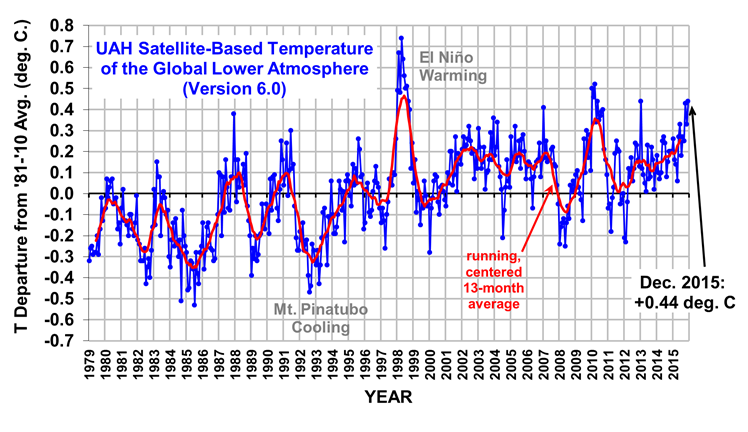Does a really hot 2015 mean climate catastrophe is around the corner?
Last week, NOAA announced that 2015 was the second hottest year on record for the United States. We should soon expect (1/13: see update at bottom) to hear an official announcement that 2015 will be the hottest in the record of global surface temperature, beating out the previous record holder, 2014. Scientists have been confident that would be the case since October.
Why 2015? El Niño and increased heating of the climate from greenhouse gas emissions. El Niño is a pattern of warm ocean water in the central Pacific that occurs irregularly and heats up the atmosphere. The 1997/1998 El Niño caused record heat in 1998. The atmospheric effect of El Nino is pronounced on the backend, so we’ll see what this one portends for 2016.
Climate skeptics have already begun rebutting the idea that these new records are challenging their favored narrative: that the last 15-20 years have not seen significant global warming, and that future projections are based on computer models that are too sensitive to CO2.
How are climate skeptics arguing those points?
- Questioning the quality of surface temperature data.
- Invoking other data sources with different records.
Do these criticisms hold up?
Is there a new problem with surface temperature data?
Recently, a group of researchers led by climate skeptic Anthony Watts challenged the official U.S. temperature record with an unpublished study, presented as a poster at the 2015 American Geophysical Union meeting. He and his co-authors applied criteria for data quality and measurement consistency to the collection of weather stations that NOAA uses to make climate records. Mainly, they looked to exclude stations that may be confounded by proximity to manmade heat sources/sinks (i.e. buildings, roads) or were moved during the analysis period. After filtering for their criteria, the researchers estimated a surface warming trend in the United States that is 2/3 as large as NOAA’s official calculations (for the trend from 1979-2008).
This study doesn’t extend to the globe or include the most recent data. Since it ends in 2008, it leaves out almost a decade. Likewise, since this article hasn’t been published (or peer-reviewed), there are questions about its methodology and conclusions. At present, it is hard to know how much its results depend on the choices the authors made in selecting stations, the validation of those choices, or why they found results different from previous studies.
The jury is still well out on this one. If this study is correct, that implies a significant downward revision of the U.S. temperature trend. But even that does not invalidate CO2-driven greenhouse warming. Without a longer period of analysis or global results, extension of this result to statements about the broader sensitivity of the climate are unwarranted.
What do other data sources say?
Climate skeptics point to satellite measurements of the troposphere as a challenge to the surface measurements. Such data show a leveling off of temperature after the 1997/1998 El Niño and the record warming years are different. 1998 and and 2010 are the two hottest years in the University of Alabama at Huntsville, with 2015 in third place.
Figure: Satellite temperature records from the University of Alabama Huntsville. Image Source: Roy Spencer.
There has been a divergence in the temperature projections from climate models and satellite data, which was recently highlighted by John Christy in Senate testimony. The simulations that modeling groups performed for the last IPCC report do run hotter over the past decade and a half than the temperature observations.
We’ve touched on that divergence before (see #7 in this post). Carl Mears, a climate scientist and expert in satellite data, wrote last year that the conclusion that climate models are fundamentally flawed is not the obvious one. Among the factors that need explanation are measurement errors in the satellite data (though those are not big enough to explain the model-data discrepancy), errors in the simulation posed to the climate models, and internal variability on the part of the real climate that is different from the model average. It will be interesting to see to what extent a big El Niño warming in 2015/2016 will resolve the variability question.
Catastrophe Imminent?
When it comes to a record year, commentary from both sides of the climate debate will probably be overheated. Any given year being the hottest on record doesn’t really mean too much in the bigger picture of climate change. Catastrophe is not around the corner because 2015 (or 2016) is or is not the hottest year on record.
But one should expect to see warm records again and again in a warming climate. The measurements of 2015 are consistent with that expectation and the criticisms we’ve seen from skeptics are not convincing otherwise.
(Update: Berkeley Earth has announced that 2015 was ‘unambiguously’ the warmest year on record according to their calculations.)
[Banner Image: MrTinDC]
